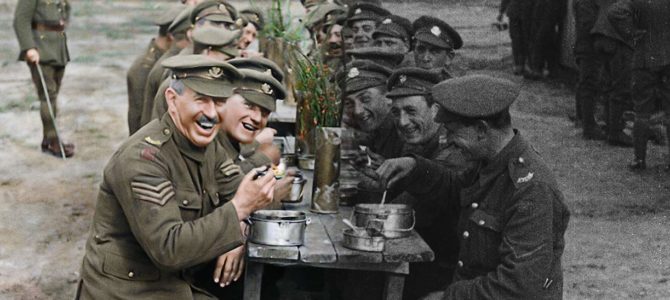
We have all seen the herky-jerky film footage of World War I, the oddly uniformed soldiers mugging for the camera in grainy fast-motion, the horse-drawn artillery and trenches and gas masks all shrouded in colorless silence. It is a glimpse into some other world, as foreign to us as the wild west or the Civil War.
The Great War has more or less remained like this in our collective imaginations. We haven’t had a “Saving Private Ryan” or a “Band of Brothers” to bring its soldiers to dramatic life, and books cannot do it the way film can. So, despite copious volumes published about World War I over the past four years, its centenary came and went without giving us anything that could really humanize the common soldiers who slogged it out on the Western Front.
That is, until now. Peter Jackson’s stunning new film, “They Shall Not Grow Old,” is not just the best documentary released last year, it is arguably the best film released last year in any genre. After a record-setting limited release in December, the film was released this weekend in 500 theaters. And no wonder. Jackson has done what no one has ever done: through a combination of technical wizardry and artistic vision, he has brought World War I to startling life, showing us for the first time the men of The Great War in their full humanity—laughing, anxious, bored, terrified, exhausted.
“They Shall Not Grow Old” is both a serious work of art and a monument to the power of documentary filmmaking. The project began more than four years ago, through a partnership between the Imperial War Museum and 14-18 Now, a World War I centenary art commission that asked Jackson to make a film using 100 hours of footage. The only requirements were that he use only that footage and that he use it in an original way. Boy, did he.
How Jackson Made the Great War Come to Life
First, Jackson and his team cleaned up and restored the century-old footage, some of which were triple duplicates. Then, they retimed it. The reels had been shot on hand-crank cameras, which gave it that herky-jerky quality. By retiming and speeding up the frame rate while digitally adding frames, they were able to smooth out the movement and render the soldiers and horses more or less as they would be if they had been filmed today.
Jackson didn’t stop there. He hired a company to colorize the footage in meticulous detail, bringing in historians to consult on the colors of British military uniforms and even traveling to European battle sites to get the landscapes right.
Timing and color were not enough, though, to bring the war fully to life. Using forensic lip readers, voice actors, and audio engineers, Jackson and his team populated the footage with a world of sound—the crack of artillery shells exploding, the creaking of horse harnesses and wagons, and, most startling, the soldiers speaking, laughing, striking a match, sighing.
The results of all this are astonishing:
All these effects are made even more powerful by Jackson’s timing. He does not introduce the fully restored film with all the color and sound until the troops first arrive at the Western Front. Here, the men and the war come alive, transformed from black-and-white Charlie Chaplin-esque caricatures into recognizable men and boys, trudging into the crucible of trench warfare.
‘We Will Remember Them’
The film’s genius isn’t just in its technical achievement. Jackson structures his narrative by following the ordinary British soldier chronologically from the outbreak of war in August 1914 through recruitment, training, deployment, trench warfare, capturing German prisoners, and returning home.
The film is book-ended by the original, black-and-white footage—which was quite by accident, owing to budget limitations that only allowed Jackson to colorize 30 or 40 minutes of film. The choice to colorize the Western Front has the effect of humanizing the men under what are undoubtedly the most inhuman conditions imaginable.
Set over all these startling images is a first-person narrative by World War I vets themselves, in snippets of recordings from interviews done in the 1960s and 70s that give emotion and immediacy to the footage. We hear the voices of those who fought the war as we watch the men who fought it. The effect is as powerful as any I’ve seen in a documentary, with the dramatic and cinematic force of a narrative action-drama.
The film’s title is take from a poem called “For the Fallen,” written in 1914 by Lawrence Binyon less than seven weeks after the outbreak of war. The British Expeditionary Force was in full retreat from Mons, having already sustained unimaginable casualties, and all hopes that the war would be short and decisive had been dashed.
The poem’s fourth stanza, which is engraved on World War I memorials and cemeteries across the English-speaking world, reads thus:
They shall grow not old, as we that are left grow old:
Age shall not weary them, nor the years condemn;
At the going down of the sun, and in the morning,
We will remember them.
Jackson’s documentary—his greatest artistic work, far surpassing the gauzy, overrated Lord of the Rings and Hobbit trilogies—lives up to its namesake, immortalizing while humanizing the ordinary British infantrymen who passed through the nightmare of the Western Front, and were then forgotten. “They Shall Not Grow Old” goes a long way toward memorializing those men as they deserve to be, and for that Jackson has made not just an historic contribution to documentary filmmaking, but to civilization itself.









